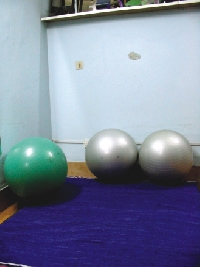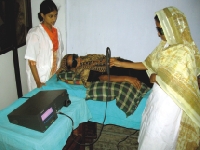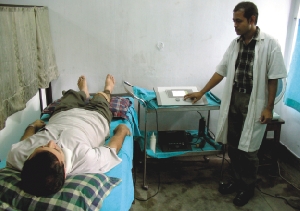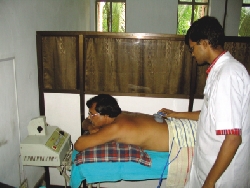|
Cover
Story
Getting
Your Life
Back
with Physiotherapy
AASHA MEHREEN AMIN
 |
| EMG-biofeedback is used to assess the activity in the muscles. |
Tahera, a thirty-something official in an international development organisation, didn't pay much attention to the little twinges of pain in her neck, shoulders and back during her long hours of sitting in front of the computer. With all the perks of having a highly paid job, came the not-so comfortable price of a sedentary lifestyle. Within a few years Tahera started to develop severe headaches and pain in almost all parts of her body. When she decided to take a break from work and study abroad, she found that her body had deteriorated so much that simple things as walking up the steps or carrying her rucksack, proved excruciating.
Trying treatments from all kinds of doctors including chiropractors and getting almost no relief, Tahera ended up at a physiotherapist's clinic as recommended by the rheumatologist she had been to. Here she was given a series of treatments that included massage, applying heat and ultrasound rays and stretching exercises to be done both at the clinic and at home. Within five months Tahera could vouch for major improvement in her condition. Back home recently, Tahera has continued with physiotherapy at Gonoshasthya Hospital in Mirpur Road in Dhanmondi. It took only a few minutes of observing how Tahera walked, stood and sat, for Dr I Manikandan, one of the leading doctors at the physiotherapy centre at the hospital, to know that one of the root causes for Tahera's pain was the way her feet were shaped and the way she carried herself. An extra in-step was put in her shoes and she had to go through sessions of various treatments that worked on each problem area. "I was becoming dysfunctional", says Tahera, "the key thing with physiotherapy is that it retains and restores mobility".
"Physiotherapy looks at the body holistically", says Dr Manikandan, a South Indian physiotherapist who heads the Physiotherapy department at the Gono Bishwabidyalay in Savar. "This means what is happening in the foot can affect, say your neck", he explains, "when you go to allopathic doctors they only treat the symptoms and do not look at the causes. We first deal with the pain and then find the causes and work on them to bring about a sustainable form of pain relief." Many patients, he adds, come to him with a load of X-rays, MRIs and other test reports as prescribed by previous doctors. But these are not always necessary to diagnose most of the ailments that involve muscular pain. "We have our own way of testing. We look at the way a person stands and walks and usually can tell what the problem is. We concentrate on the movements and functions of the body. When you have pain your movement is affected; then the functions are impaired."
 At the centre in Ganoshasthya Hospital, where a series of treatments are applied depending on the severity of the condition, absolutely no drugs are prescribed. Often this comes as a surprise to patients used to popping pills as instructed by previous doctors. But after a few sessions when the pain is considerably reduced, patients realise the benefits of this kind of treatment. This form of treatment includes biomechanics (that studies the way muscles are functioning), exercise therapy, electrotherapy and massage. At the centre in Ganoshasthya Hospital, where a series of treatments are applied depending on the severity of the condition, absolutely no drugs are prescribed. Often this comes as a surprise to patients used to popping pills as instructed by previous doctors. But after a few sessions when the pain is considerably reduced, patients realise the benefits of this kind of treatment. This form of treatment includes biomechanics (that studies the way muscles are functioning), exercise therapy, electrotherapy and massage.
Nasrin Akhter (not her real name) now in her late 50s, after being active all her life, suddenly found herself completely immobile. She had fallen when she missed a few steps while getting into a building. Her fall left her in severe pain in her right knee and she was quite sure she had broken her leg. A leading orthopaedist announced that Nasrin needed bone replacement surgery. But she was not convinced, as the X-rays did not show any fracture in the bone. She however, diligently took the drugs prescribed by him, -- one for pain relief, another for bone retention, two times a day. But soon she started throwing up and was feeling far from better. Nasrin spent two months in bed in agony until her son convinced her to go to Bangkok for treatment.
 |
| Dr I Manikandan treating a patient. |
At the hospital in the Thai capital, the doctors diagnosed her with an 'abused ligament', informing her that the drugs she had been taking were not right for her condition and that they had, actually, aggravated because of fluid retention from two months of inactivity. They gave her steroids for the pain and asked her to find a physiotherapist as soon as she got home. Nasrin ended up at the Gonoshasthya Hospital under the care of Dr Jamlin Escaria, an Indian physiotherapist from Kerela. For a whole month, Nasrin went to the Gonoshasthya Centre everyday for the various forms of treatment that included stretching of the muscles, massage with Ayurvedic oil, applying heated herbal packs as well as electrical pads. She was also instructed to do exercises at home, how to maintain good posture, how to walk properly and so on. Some of the treatments, such as when her deteriorated muscles were tightened, were quite painful but after a few sessions, Nasrin could feel the difference in her leg muscles. Within a month the pain was gone and she could walk again.
 |
The physiotherapy centre of Gonoshasthya Hospital in Savar. |
The success, therefore, largely depends on the patient's perseverance and willingness to take responsibility for his/her own health. After the treatments at the physiotherapist's, patients are asked to continue certain exercises at home; this is crucial for long term prevention.
Physiotherapy offers no quick fix and relies on the patient taking responsibility to do the follow up exercises. "The way to know whether the physiotherapist is good, is to see whether he gives you a self-treatment programme," Tahera says. Exercises and treatments are different for different problems and only a physiotherapist can tell a patient what is appropriate for that particular patient.
 |
| Figures showing various flexibility exercises and postures that have to be maintained even after the treatment is over. |
Irene Salam (not her real name) was in her fifth year of BUET when she badly sprained her knee and had to go to take her finals with the help of a crutch. As the pain continued, threatening to debilitate her completely, Irene went to a well-known orthopaedist who gave her a few painkillers but could not diagnose her. For four years Irene suffered but had no clue about the cause. Finally, when she came to the Gonoshasthya Hospital, her physiotherapist informed her that her kneecap had been displaced which led to pain in various parts of her body. "I had pain in the oddest of places, in my neck, shoulders and back," says Irene. Irene was given ultrasound heat treatment, Ayurvedic oil massages and heat-pads plus an extensive exercise routine to be maintained in the future. "One month later, all the pain had disappeared," she says, "what was more, the doctor explained in detail the logic of how the body operates and what was happening to my muscles." Irene then went to Germany and promptly neglected to do the exercises prescribed for her. Soon enough, the pain came back and forced Irene to start physiotherapy treatment again.
 |
Thera-balls help in flexibility exercises. |
Physiotherapy thus can only work if the patient is committed to the healing process by maintaining a proper exercise routine that will ensure that the restored muscle or relieved nerve, does not regress to the former state. The stresses of modern, mechanised life ensure the emergence of multiple health problems, especially those caused by sedentary lifestyles. We spend more and more hours in a sitting or standing position and horribly neglect the proper functioning of our muscles by not getting enough or even any, exercise. This is why physiotherapy has become so important in advanced countries. Even in a country like Bangladesh, the need for good and adequate physiotherapists cannot be emphasised enough.
But physiotherapy as a discipline has not received the support or interest as it has in neighbouring countries. There are only 350 physiotherapists in Bangladesh. Most of them have done their MBBS degree in Physical Medicine followed by a two-year graduate course. These physiotherapists treat their patients with a combination of physical therapies and drugs. Dr Manikandan complains that physiotherapists like himself who prescribe no medicine whatsoever, are almost non-existent in Bangladesh as there are no government posts for them. He can come up with the name of only one such physiotherapist at the Pangu Hospital in Mirpur.
 |
| Laser therapy for pain relief. |
Currently, there are around six institutes that offer courses in physiotherapy. This includes Gono Bishwabidyalay, Centre for Rehabilitation of the Paralysed (CRP), Bangladesh Medical College and Pangu Hospital. Gono Bishwabidyalay, which offers both diploma and Bachelor courses in physiotherapy, is the only institution that offers a two year Masters programme in the subject. It has also invested heavily in procuring latest technologies in electrotherapy such as laser therapy, EMG (electromyogram, tracing representing electrical activity of the muscle), muscle stimulator and ultrasound.
 |
Only a qualified physiotherapist can tell a patient what is appropriate for that particular patient. |
The government should actively support this profession, as it is such a vital component of today's health care. "Every orthopaedic hospital, in say, India, has a physiotherapy department," says Dr Manikandan. Physiotherapy, in fact, is vital in many health treatments. "In the ICU, for example, where the patient may-be unconscious, secretions of the mouth often get accumulated in the lungs doubling the chance of infection," explains Manikandan, "our role would be to take the help of 'gravity' using a 'post oral drainage technique' to drain out the fluid". In standard hospitals abroad, he adds, after cardiac surgery a patient is sent to the physiotherapy centre where he is trained to build up his strength gradually in order to resume normal life. Physiotherapy is essential for sports people who regularly suffer from muscle, bone and ligament injuries.
 |
| Using IFT (Interferential Therapy for pain relief of the back). |
The most common use of physiotherapy is in orthopaedic conditions such as fractures, dislocations, spondylitis, postural aches, degenerative conditions, strain injuries, rheumatoid arthritis and so on. Impairment of the nervous system from say, strokes or paralysis, spinal cord lesions, also requires physiotherapy. In fact, the discipline can be applied to innumerable ailments: to cure obesity; in obstetrics to ease labour, delivery and postnatal problems; for respiratory problems such as asthma and bronchitis; in congenital problems of children such as cerebral palsy, club foot, muscular dystrophy and spinal muscular atrophy; in burn treatments; and before and after plastic surgery to keep the grafted skin healthy. Physiotherapy is also becoming important in ergonomics, the science of setting up things in the workplace in a healthy way; for instance, how office furniture should be set up to ensure maximum comfort to employees.
Thus the scope and need for physiotherapy is endless. All that is needed is a change in attitude. There has to be collaboration and trust between allopathic doctors and physiotherapists. Opportunities to train physiotherapists have to be created: the Gono Bishwabidyalay has already trained several batches of physiotherapists and has currently sent a team to India to be trained in ICU treatments. Most of all, physiotherapy must be recognised as an important discipline which can provide cost effective, sustainable cures for a myriad of ailments. For Bangladeshis, already overdosed with too many drugs and plagued by constant misdiagnosis, this kind of 'no drugs' treatment could not be more welcome. Copyright
(R) thedailystar.net 2005 |
| |
